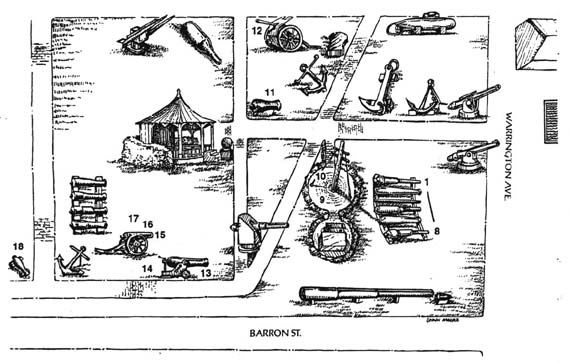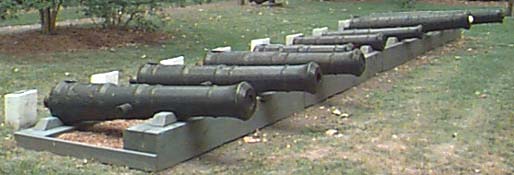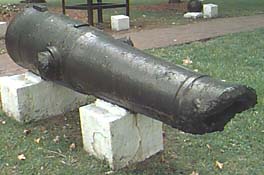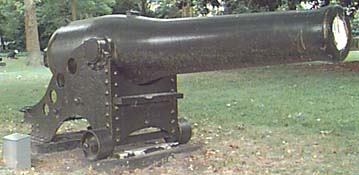|
Click on a map location
number to learn more
|

|
|
 |
1
4.2-inch (30-pdr) Navy Parrott rifle
Model of 1861
(no shipboard service)
|
|
Manufactured by West Point Foundry in 1864 and delivered to New York Navy Yard, this size has five groove rifling with right hand twist. Displayed here is Navy Registry Number 307 of 407 made for the U.S. Navy during 1861-65. It was inspected by Robert B. Hitchcock and weighs 3,500 pounds. Served by a crew of nine, including a powder boy, a charge of 3.25 pounds of black powder propelled a 29-pound shell up to 6,700 yards at 25 degrees elevation and 27 seconds of flight time. Number 307 was loaned to the Treasury Department in March 1864, thus it did not see service on a U.S. Navy ship. It was returned to the Navy and assigned to Norfolk Naval Yard in February 1876. Declared obsolete, it was assigned "for yard use" at Norfolk on September 17, 1890.
Top
|
 |
2
5.3-inch (60-pdr) Navy Parrott rifle
converted to 5.3-inch breechloading rifle
USS KEARSARGE
|
|
This rifle was originally manufactured by West Point Foundry in 1865. Used only by the Navy, 110 of this size Parrott rifle were made in 1864 and 1865, and all were inspected by Robert B. Hitchcock. Rifling is seven grooves of right hand twist. A 6-pound powder charge was used to propel 60-pound shell and 50-pound shell.
The initial assignment and early history of Registry Number 61 are unknown; it apparently remained in storage at Washington Navy Yard where it was reported in August 1879. It was converted to a breechloader at Washington Navy Yard in June 1880, reducing its weight from 5,400 to 5,242 pounds. It was then sent to Boston Navy Yard where it was mounted on sloop-of-war USS KEARSARGE the next month and later fired six times in practice. Its last reported location was at Portsmouth (New Hampshire) Navy Yard in January 1887.
Top
|
 |
3
6.4-inch (100-pdr) Navy Parrott rifle
converted to 6.4-inch breechloading rifle
|
|
The Navy purchased 352 of these rifles from West Point Foundry during the years 1861-65. Rifling is nine grooves of right hand twist. They were served at sea by a full crew of 17, including a powder man. Ten-pound powder charges provided expected ranges for 100-pound solid shot or long-range shells of about 6,900 yards at 25 degrees elevation and about 28 seconds time of flight. An 80-pound short shell had a range of 7,810 yards at 30 degrees elevation and 32.4-seconds time of flight.
Registry Number 75 was made in 1862 and served for the remainder of the Civil War on the side-wheeler USS Florida. In 1878, it was returned to West Point Foundry where it was converted to a breechloader. This alteration increased its original weight of 9,8500 to 10,266 pounds. It served on then-practice ship Wyoming at the Naval Academy until June 1884.
Top
|
 |
4
XI-inch Dahlgren shell gun
(converted to 8-inch rifle)
USS TRENTON
|
|
The XI-inch shell gun is the largest of the five shell gun types faithful to Dahlgren's patented design. Like the IX-inch, these proved extremely durable, the only known failure being one that burst during extreme proof at the 1,125th round. Eight foundries made 465 of this size during the years 1856-1864. A 20-pound propellant charge would give 136-pound shell ranges up to 3,650 yards at 15 degrees elevation and 16.5-second time of flight. A 15-pound charge was used to fire 141-pound shrapnel up to 1,710 yards at 5 degrees elevation and 5.6-second time of flight.
On display is original smoothbore Registry Number 181 made at Builders Foundry in 1864. It was inspected by Timothy A. Hunt and originally weighed 15,740 pounds. It was inventoried at New York Navy Yard and evidently saw no service prior to February 1876 when it was sent to West Point Foundry for conversion to an 8-inch rifle via insertion of a steel sleeve with 15-groove rifling of right hand twist. It was assigned new Registry Number 11 as an 8-inch rifle, inspected by Francis J. Higginson, and returned to New York Navy Yard. Its original markings remain along the base line near the breech while the original trunnion markings were turned off and new identification markings applied. Its new weight, after alteration, is 17,330 pounds. It was then assigned to post-Civil War screw frigate USS Trenton on which it served until September 1881. It was sent to the Naval Academy at Annapolis in May 1882 and reported on board the practice ship Wyoming in December 1882.
Top
|
 |
5
6.4-inch (100-pdr) Navy Parrott rifle
USS FRANKLIN
|
|
The Navy purchased 352 of these rifles from West Point Foundry during the years 1861-1865. Rifling is nine grooves of right hand twist. They were served at sea by a full crew of 17, including a powder man. Ten-pound powder charges provided expected ranges for 100-pound solid shot or long-range shells of about 6,900 yards at 25 degrees elevation and about 28-second time of flight. An 80-pound short shell had a range of 7,810 yards at 30 degrees elevation and 32.4-seconds time of flight.
Register Number 165 was produced in 1863, weighs 9,727 pounds, and was inspected by Robert B. Hitchcock. It served on screw-frigate USS FRANKLIN at least through December 1872. It was reported at Norfolk in August 1879.
Top
|
 |
6
IX-inch Dahlgren shell gun
|
|
These smoothbore shell guns were the most reliable Navy cannon prior to, and during, the Civil War; only one was reported to have burst. Designed by John A. Dahlgren, 1185 were made during the years 1855-64 by six foundries. A full crew of 17 served this type cannon when in pivot or used singly. The expected ranges for 72.5-pound shell were up to 3,357 yards with a 10-pound propellant charge, 15 degrees elevation, and a flight time of 14.7 seconds. Thirteen-pound charges would provide ranges up to 3,450 yards for the same projectile. A 10-pound powder charge was to give 75-pound shrapnel ranges up to 1,690 yards at 5 degrees elevation and 5.9-second time of flight.
Registry Number 887 was made in 1864, by Cyrus Alger & Co., with a weight of 9,329 pounds. Its first assignment commenced in November 1867 on the screw steamer USS CHIMO, whose name had been changed to USS Piscataqua by the time number 887 was off-loaded at New York Navy Yard in December 1870. It was immediately transferred to USS TENNESSEE on which it served at least until November 1879. Total firings were 111, of which 21 were while serving on CHIMO/PISCASTAQUA. Its last known service was aboard USS ENTERPRISE from July 1887 to April 1890 when it was off-loaded at New York Navy Yard.
Its trunnions are shorter than those on Registry Number 242. This was a post-manufacture modification to facilitate use on the wrought iron carriage on which it mounted rather than on a wooden carriage for which it was originally designed.
|
Top
 |
7
5.3-inch Navy Parrott rifle
(no shipboard service)
|
|
This rifle was manufactured by West Point Foundry in 1865. 110 of this size Parrott rifle, used only by the Navy, were made in 1864 and 1865, and all were inspected by Robert B. Hitchcock. Rifling is seven grooves of right hand twist. A 6-pound powder charge was used to propel 60-pound shot and 50-pound shell.
Number 56, weighing 5,430 pounds, was assigned to Washington Navy Yard in August 1866. It was fired 14 times as part of an experimental battery at Annapolis between July 1873 and September 1884.
Top
|
 |
8
3.67-inch (20-pdr) Navy Parrott rifle
Model of 1861
USS SUMTER
|
|
Designed by, and named for, Robert Parker Parrott, owner of West Point Foundry at Cold Spring, New York, the 3.67-inch Parrott rifle has five-groove rifling with right hand twist. Displayed here is Registry Number 115 of 336 manufactured for the U.S. Navy from 1861-65. It was produced in 1862 and weighs 1,795 pounds. Served by a crew of seven, including a powder boy, a 19-pound shell propelled by a 2-pound charge of powder reached ranges of 4,400 yards with 15 degrees elevation and a flight time of approximately 17 seconds. This particular Parrott rifle served on wooden screw-steamer USS SUMTER which sank in a collision with the transport steamer GENERAL MEIGS on June 24, 1863 off Smith Island, North Carolina. It was recovered from the wreckage and delivered to Norfolk Naval Yard in 1866 where it has remained ever since. It was declared obsolete and designated "for yard use" at Norfolk on September 17, 1890.
|
Top
|
|
9
3.4-inch (12-pdr) Dahlgren
rifled steel boat howitzer
(no shipboard service)
|
|
Registry Number 298 displayed here weighs 791 pounds, has 12-groove rifling, and is one of twelve rifles of this type made of steel. It was made at Washington Navy Yard in 1863 and sent to Norfolk. It apparently never saw service on any ship and was ordered "for yard use" at Norfolk on September 17, 1890. Only three of these steel rifles are known to have survived.
|
Top
|
10
3.4-inch (12-pounder) Dahlgren rifled bronze boat howitzer
USS WILLIAM G. ANDERSON
|
|
Designed by, and named for, John A. Dahlgren, 423 3.4-inch rifled boat howitzers were produced from 1861 to 1865 at Washington Navy Yard. In a single Registry Number series and using the same castings as for the smoothbore heavy 12-pdr boat howitzer, also displayed in Trophy Park, 411 were cast of bronze and 12 of steel. Served by a crew of five, including a powder boy, a 1-pound powder charge propelled a 12-pound shell an expected range of 1,770 yards with 5 degrees elevation and a flight time of approximately 6 seconds. This bronze specimen, Registry Number 249 with 12-groove rifling and weighing 876 pounds, was sent to Pensacola Navy Yard after its manufacture in 1863. It served on the bark USS WILLIAM G. ANDERSON until shortly after the Civil War. It later served on the single-turret monitor USS MAHOPAC from which it was off-loaded at Norfolk during June 1889. It was declared obsolete and designated "for yard use" at Norfolk by order of September 17, 1890. Two other specimens, Registry Numbers 314 and 403, are displayed near the 4th Street gate.
Top
|
|

|
11
32-pounder chambered cannon
length 79 inches, 33 hundredweight
USS PENNSYLVANIA
|
|
Three hundred cannons of this type were manufactured in 1846 and 1847 at Fort Pitt (128), Tredegar (112), and West Point (60) Foundries. Initially made with chambers, most were subsequently bored out and the later ones made without chambers. They served on intermediate sloops-of-war and on the spar decks of first class frigates and line-of-battle ships.
The reassembled fragments on display were recovered many years after the Civil War from the remains of USS PENNSYLVANIA which was serving as a receiving ship at Norfolk. To prevent appropriation by Confederate forces, she was burned at Norfolk Navy Yard on April 20, 1861. Long submersion caused erosion of most of the identifying marks on this gun; however, Navy records place Registry Numbers 213 & 214 onboard USS PENNSYLVANIA at the time of her destruction. Both were made at Richmond's Tredegar Foundry in 1846 and inspected by John S. Chauncey. This is most likely one of those two guns.
Top
|
|
12
32-pounder Navy gun
length 112 inches, 57 hundredweight
(USS CONGRESS)
|
|
A total of 744 smoothbore guns of this type were manufactured at five different foundries from 1846 to 1852. Intended service was on first class frigates and ships of the line. Registry Number 125 was made at Fort Pitt Foundry in 1847, inspected by John S. Chauncey, and has a marked weight of 50.0.04 (6,500 pounds). Number 125 was lost on USS CONGRESS when she burned and sank from damage inflicted by the ironclad CSS VIRGINIA in Hampton Roads on March 8, 1862. Most of USS CONGRESS' guns were recovered in 1864 but were declared unserviceable.
Top
|
 |
13
IX-inch Dahlgren shell gun
USS HURON
|
|
These smoothbore shell guns were the most reliable Navy cannon prior to, and during, the Civil War; only one was reported to have burst. Designed by John A. Dahlgren, 1185 were made during the years 1855-64 by six foundries. A full crew of 17 served this type cannon when in pivot or used singly. The expected ranges for 72.5-pound shell were up to 3,357 yards with a 10-pound propellant charge, 15 degrees elevation, and a flight time of 14.7 seconds. Thirteen-pound charges would provide ranges up to 3,450 yards for the same projectile. A 10-pound powder charge was to give 75-pound shrapnel ranges up to 1,690 yards at 5 degrees elevation and 5.9-seconds time of flight.
Registry Number 1178 weighs 9,240 pounds and was made in 1864 at Fort Pitt Foundry where it was inspected by John M. Berrien. It was sent to League Island and saw no service until installed on the post-Civil War single-screw iron gunboat USS HURON in October 1875. The USS HURON cruised the Caribbean and Gulf of Mexico for two years until wrecked near Nags Head, North Carolina on November 24, 1877. This tube was later recovered from the wreck and sent to Norfolk Naval Shipyard. Its trunnions are shorter than those on Registry Number 242. This was a post-manufacture modification to facilitate use on the wrought iron carriage on which it was mounted rather than on a wooden carriage for which it was originally designed.
Top
|
 |
14
IX-inch Dahlgren shell gun
USS RICHMOND
|
|
These smoothbore shell guns were the most reliable Navy cannon prior to, and during, the Civil War; only one was reported to have burst. Designed by John A. Dahlgren, 1185 were made during the years 1855-64 by six foundries. A full crew of 17 served this type cannon when in pivot or used singly. The expected ranges for 72.5-pound shell were up to 3,357 yards with a 10-pound propellant charge, 15 degrees elevation, and a flight time of 14.7 seconds. Thirteen-pound charges would provide ranges up to 3,450 yards for the same projectile. A 10-pound powder charge was to give 75-pound shrapnel ranges up to 1,690 yards at 5 degrees elevation and 5.9-seconds time of flight.
Registry Number 242 was made in 1859 by Cyrus Alger & Co., weighs 9,045 pounds, and was inspected by William R. Taylor. Until July 14, 1865, it served on USS RICHMOND and was fired 250 times. It served on the practice school ship SABINE from March 1872 until off-loaded at Portsmouth (New Hampshire) Navy Yard in July 1876.
Its trunnions are longer than those on the other two specimens in the park. This was to facilitate use on a wooden carriage for which it was originally designed.
Top
|
|
15
12-pounder bronze Dahlgren boat howitzer
USS QUINNEBAUG
|
|
One of Dahlgren's early designs was the bronze light smoothbore boat howitzer intended for launches of sloops-of-war, cutters, and as fieldpieces to be used in amphibious operations. 183 howitzers of this light model were produced at Washington Navy Yard from 1848 to 1870; two others were made by Cyrus Alger & Co. of Boston, Massachusetts. On display here is Registry Number 130, cast in 1870 with a weight of 432 pounds. It was inspected by Francis M. Ramsay and sent to New York Navy Yard in April of that year. It served on the screw frigate USS GUINNIERE from May 1870 to March 1872. Commencing in October 1878, it served on the twin-screw gunboat USS QUINNEBAUG, evidently until June 1889 when it was at New York Navy Yard. It was declared obsolete and designated "for yard use" at Norfolk by order of September 17, 1890.
Top
|
|
16
6-pounder bronze field gun
(Model of 1841)
|
|
This smoothbore gun was the most common army field piece during the Mexican War and at the beginning of the Civil war. It was essentially displaced, in both North and South, by rifled fieldpieces and more efficient 12-pounder Nepoleons early in the Civil war. The markings on this tube reveal it is Registry Number 352 made in 1847 by James T. Ames (name changed to Ames Manufacturing Co. in 1850). It was inspected by James Wolfe Ripley, Union Army Chief of Ordnance during the Civil War, and weighs 884 pounds. No known record indicates its service history.
Top
|
|
17
12-pounder bronze Dahlgren boat howitzer
USS CONSTELLATION
|
|
A total of 456 boat howitzers of this heavy model were produced by Cyrus Alger & Co. (57), Ames Manufacturing Co. (202), and Washington Navy Yard (197) from 1849 to 1865. They were initially intended for launches of frigates and as fieldpieces in amphibious landings, but they saw general use on nearly all types of ships and boats during the Civil war. On display is Registry Number 36 made in 1854 at Washington Navy Yard and shipped to Norfolk for the ship USS CONSTELLATION on which it served until April 1866. It was placed on board the steam tug PINTA for less than a month in April 1876. An ordnance survey of June 20, 1888 noted its vent was badly worn. It was declared obsolete and designated "for yard use" at Norfolk by order of September 17, 1890.
Top
|
|
18
32-pounder Navy gun
USS ST. LAWRENCE
|
|
A total of 744 smoothbore guns of this type were manufactured at five different foundries from 1846 to 1852. Intended service was on first class frigates and ships of the line.
Registry Number 384 was made at Tredegar Foundry in 1848, inspected by John S. Chauncey, and has a marked weight of 57.2.18 (6,458 pounds). It was initially sent to Portsmouth (New Hampshire) Navy Yard and served for an unknown period on USS ST. LAWRENCE. It was reported serving as a post in Portsmouth Navy Yard in July 1867.
Top
|
|